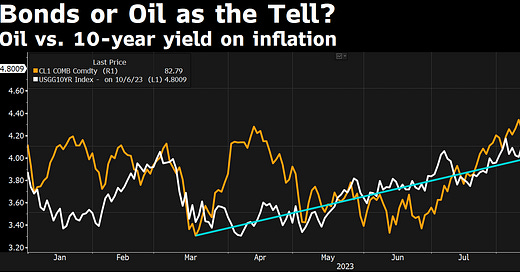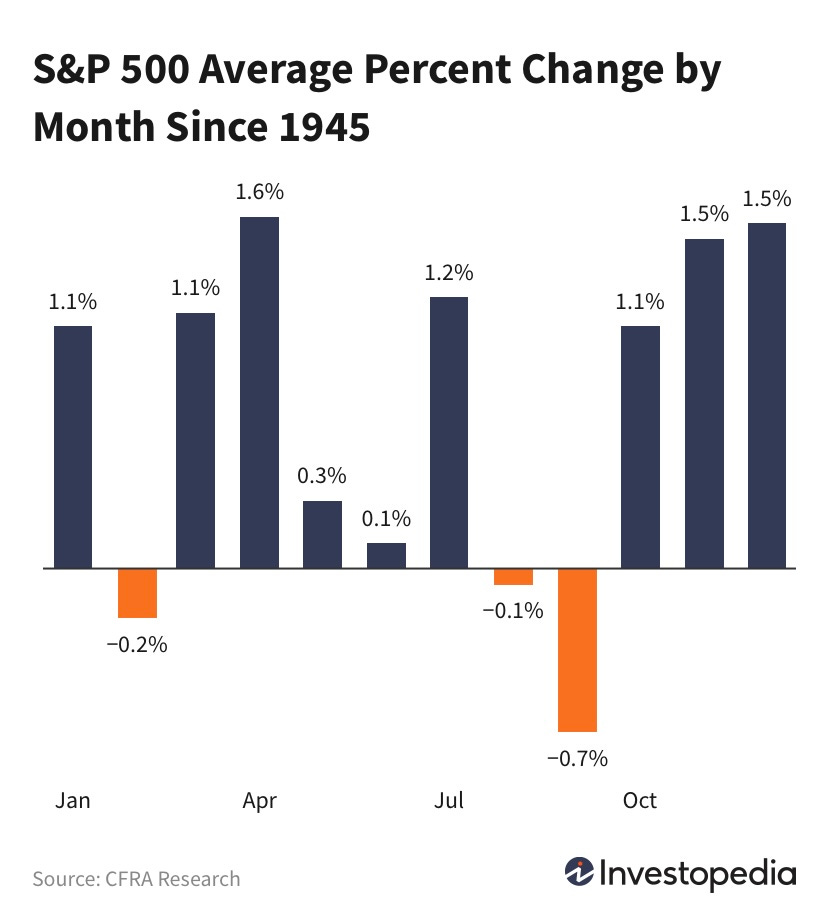Weekly Good Reads: 5-1-1
Hot Jobs Data, Rate Spike, Financial Condition, Moai (Friendship)
Welcome to Weekly Good Reads 5-1-1 by Marianne O, an investment practitioner and author of
about investing, economy and wellness ideas. Every week I include 5 links to relevant economic and investment, finance and wellness/idea pursuit as well as 1 important chart and 1 term to know. All the Weeklies are here and here is the index of charts and terms. You can easily subscribe to my newsletter by clicking below.Thank you so much for reading and supporting my work 🙏.
Market and Data Comments
The biggest financial surprise this week was the non-farm payrolls (a comprehensive job report) in the US that added 336,000 jobs in September, more than double what was expected. The previous two months’ jobs were revised up by 119,000 also.
The robust job data stoke fear of further tightening by the Fed. The 10-year US government bond yield spiked up 23bp to hit 4.8% at the end of the week. 30-year bond yield breached 5%, the first time since 2007.
Stocks decided to focus on the good economic news. As the chart below shows, while job gains were robust, wage gains (private sector) were subdued, rising 0.2% in September (4.2% year-on-year), 0.1% lower than expectations, and the unemployment rate was unchanged.
The Chinese official manufacturing Purchasing Managers’ Index (PMI) has risen for four consecutive months and has moved into expansionary territory. The worst seems to be over for China albeit recovery is weak, and the property sector and local government debt problems linger.
From the chart above, while bond yield surged, WTI oil price dropped almost 9% (Brent oil, -11%) this week due to fear of slowing global fuel demand under the weight of higher interest rates. Europe is expected to fall into recession in 2H 2023.
One more point about higher for longer interest rates made by famous investor Howard Marks in a recent Bloomberg interview: credit/bonds are good contenders for investors as bonds can now give them equity-type returns. That is a sea change in an investor’s portfolio decision.
Next week, we shall monitor the FOMC minutes, the US September PPI on Wednesday and CPI on Thursday, and China’s September exports, CPI and PPI on Friday, and their aggregate financing (loan).
Economy and Investments (Links):
Corporate America Is Ignoring Jay Powell and Bingeing on Debt (Bloomberg)
Mira Murati, the young CTO of OpenAI, is building ChatGPT and shaping your future (Fortune)
Cancelling Michael Lewis (The Big Picture)
Lewis's take on FTX collapse and trial:
But the question is--and the trial is going to get to this--what was the intent? How did you get in the situation? When you get in the situation? And where did you actively start to, like, deceive people about this?
There's no good outcome. I mean, he's probably going to jail. But it is up until, you know, like May or April of last year an instantly solvable problem, indeed a drop in the bucket of his assets. And -- that he lets it get to where it gets.
The above excerpt is from The Washington Post interview with author Michael Lewis on the release of his book: The Rise and Fall of a New Tycoon. The ongoing trial of Sam Bankman-Fried will answer some of the above questions. The lesson here is if you know of a problem and ignore how bad it can go, it is almost certain that it will get to that bad. So, do not ignore the critical voice in your head.
Finance/Wealth (Link):
Factor ETFs Fail to Deliver Their Promised Outsize Returns (WSJ or click here)
Another great read is the three-part series on how the Fed is broke by
. You will understand how the Fed “creates” money during quantitative easing and “destroys” money in quantitative tightening.Wellness/Idea (Link):
Moai—This Tradition is Why Okinawan People Live Longer, Better (Blue Zones)
Researchers found that our social connections can have a long-term impact on our health and happiness. We mimic the habits of our three closest friends. If they share similar values, health habits, and life goals with us, then they likely experience less stress, be happier, and live longer. Those with a group of lifelong friends who can provide various types of support will have a strong safety net.
One Chart You Should Not Miss: The Federal Reserve Monthly Financial Condition Index (1-year and 3-year lookback)
“Financial Conditions” is a somewhat vague economic concept as admitted by the Fed. They generally measure how changes in several factors (including monetary policy) impact asset prices and interest rates and can potentially affect the real economy.
The Fed created a new Financial Condition Index, which looks at how changes in seven financial variables - the federal funds rate, the 10-year Treasury yield, the 30-year fixed mortgage rate, the triple-B corporate bond yield, the Dow Jones total stock market index, the Zillow house price index, and the nominal broad dollar index - cumulatively affect real GDP growth in the next 1 year using a 1-year lookback and a 3-year (baseline) lookback window.
The higher the index, the tighter the financial conditions. In the chart below, the 3-year lookback index points to a drag of about 0.6% to real GDP growth in the next 1 year.
The Fed considers changes in the financial condition in interest rate decisions.
One Term To Know: October Effect
Investors fretted about the October Effect as October witnessed major market crashes, e.g., the 1929 market crash and the 1987 Black Monday.
However, CFRA research found since 1945, October returned a positive 1.1% on average. September saw an average return of -0.7%, the worst among all months, giving the term “September Effect.”
CFRA did find stock price volatility in October was higher than average.
October Effect is more a psychological bias than fact.
Please do not hesitate to get in touch if you have any questions! If you like this weekly, please share it with your friends or subscribe to my newsletter.









Thank you @Marianne O, CFA for the mention and recommendation. I am truly very honored. Also, great list of excellent reads here that you have recommended.